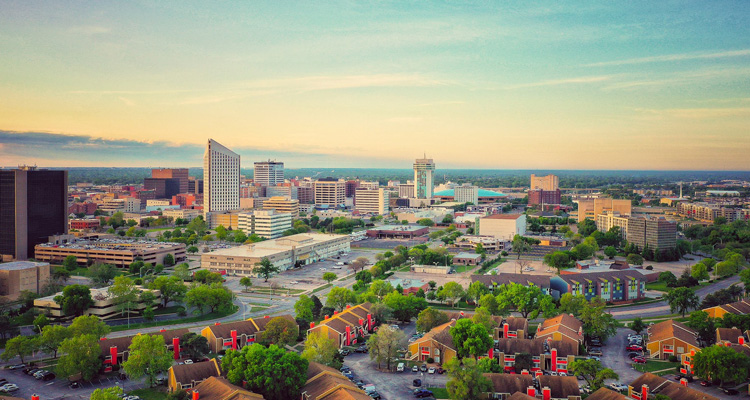February Investor Meeting Explores How Quality of Place Attracts Quality Talent
By Emily Barnwell


Investing in the Wichita region’s quality of place is an investment in the area’s talent. That was the key message of the Partnership’s first Investor Meeting of 2025.
The Feb. 12 event brought together regional industry and community leaders to downtown Wichita’s Brick & Mortar.
Partnership Co-Chairs Aaron Bastian and Charlie Chandler started the meeting by reviewing the Partnership’s key 2024 accomplishments. They outlined how the strategic priorities of Jobs, Talent and Quality of Place are propelling the region forward in 2025.
Partnership President Jeff Fluhr shared the team’s compelling ROI figures, detailed in the Leveraging Your Investment document. He also provided a high-level overview of downtown Wichita's past, present, and future, reinforcing how a vibrant urban core strengthens the entire region.
Wichita’s 2010 Project Downtown master plan drove $1.7 billion in investment and more than $760 million in the project pipeline.
Fluhr noted transformational projects such as the Kansas Leadership Center, Cargill, the Kansas College of Osteopathic Medicine, the emerging biomedical corridor which includes the Wichita Biomedical Campus℠, Exploration Place’s EP2 Initiative, the development surrounding Equity Bank Park, new residential units and Chase Koch’s investment downtown.
This led to the introduction of the Downtown Wichita Action Plan (Action Plan) and the Hutch Downtown Master Plan – strategic roadmaps for the continued revitalization and transformation of Wichita and Hutchinson’s urban cores. His remarks set the stage for the event’s dynamic panel discussion centered around the impact and future of these master plans.
The conversation featured Downtown Wichita Executive Director Heather Schroeder and Hutchinson/Reno County Chamber of Commerce President and CEO Debra Teufel. The panelists opened by explaining the importance of master planning.
“Downtown plans provide a cohesive vision for growth, ensuring that individual projects align with the community’s goals. Rather than scattered investments, a plan offers guidance on design, materials and building placement to create a more connected and pedestrian-friendly district. Beyond aesthetics, these plans also shape how downtowns function – identifying gaps in housing, entertainment and dining and strategically clustering key amenities to foster vibrant, thriving spaces,” shared Schroeder.
"Planning first ensures community input, builds buy-in and creates a clear roadmap for key projects. It helps identify opportunities – whether filling gaps with new development or rethinking underutilized buildings to shape downtown’s future with intention,” said Teufel.
The discussion then led to how these intentional plans help drive economic development opportunities and encourage workforce retention and attraction.
“Across the country, top employers, especially in tech and engineering, are choosing downtown locations because today’s workforce values walkable access to dining, entertainment and social experiences. Even for businesses outside the urban core, a vibrant downtown makes Wichita more competitive in the race for talent. We’re not just competing on the cost of living – we need to give people reasons to come downtown and help them picture their life here – a life that’s active with plenty of options,” explained Schroeder.
"We saw a major shift in downtown Hutch’s office market after one tech company relocated downtown for walkable amenities and quality of life. It sparked another tech company to scale up and invest $1.5 million in expansion. Now, the office market is nearly full,” said Teufel.
Schroeder and Teufel then touched on downtown trends and how they influence economic development and how industry leaders can help support the development of quality places.
Both shared that as downtown populations continue to grow and diversify, so does the demand for a mix of housing options and essential services. This includes everything from restaurants and salons to medical offices, pet care and grocery stores.
Schroeder shared that new market research indicates a significant surge in demand for residential, commercial and hospitality space in downtown Wichita over the next 5 to 10 years. The findings show that downtown can support 3,765 new residential units within five years, along with 676,000 to 917,000 square feet of office space and 530 to 660 hotel rooms over the next decade.
Bastian and Chandler concluded the meeting with a call to action, urging attendees to deepen their commitment to the Partnership and join in on Downtown Wichita's master planning process.
“We are so fortunate that we have people in our community willing to invest in our future. The momentum I am seeing today is nothing like I have ever seen before. There is extreme purpose in what the Partnership is doing, and it is laying a strong foundation for generations to come,” expressed Chandler.
They encouraged audience members to participate in the Action Plan Kickoff Open House scheduled for March 4 at WAVE. They emphasized that an investment in quality of place is an investment in quality talent – one of the key priorities of the Partnership's capital campaign.
“When Fidelity Bank was looking to expand, we had a lot of different options. Do we want to leave downtown? Do we want to build somewhere else? As we looked at the future of our city, the answer became clear – downtowns are strong, and they make strong cities. This is your invitation to get involved, to make an impact on the Wichita region.”
Throughout the meeting, audience members were encouraged to answer a series of questions about what they envision for the future of their downtown. Their feedback, along with insights gathered from upcoming community engagement events, will help shape the Action Plan. Click here for a 60-second survey to share your thoughts.